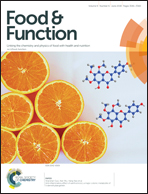Comparative efficacy of vanilloids in inhibiting toll-like receptor-4 (TLR-4)/myeloid differentiation factor (MD-2) homodimerisation†
Abstract
Vanilloid (4-hydroxy-3-methoxyphenyl benzenoid) containing foods are reported to possess many biological activities including anti-inflammatory properties. Homodimerisation of the Toll-like receptor-4 (TLR-4)/Myeloid differentiation factor 2 (MD-2) complex results in life-threatening complications in inflammatory disorders. In this study, we report activity of vanilloids in inhibition of TLR-4/MD-2 homodimersization and their molecular interactions with the receptor. The inhibitory activities of vanilloids were assessed in vitro by determining their antagonistic actions of lipopolysaccharide from Escherichia coli (LPSEc) in activation of TLR-4/MD-2 homodimerisation in TLR-4/MD-2/CD-14 transfected HEK-293 cells. The in vitro anti-inflammatory activity of vanilloids was also determined using RAW 264.7 cells. All the vanilloids were found to be active in the inhibition of TLR-4/MD-2 homodimersiation and nitric oxide production in RAW 264.7 cells. Rigid and flexible molecular docking studies were performed to gain insight into interactions between vanilloids and the binding site of the TLR-4/MD-2 complex.



 Please wait while we load your content...
Please wait while we load your content...